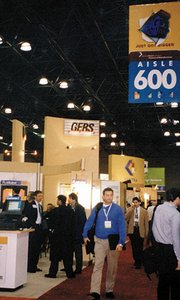Technology Is Key At NRF Annual Convention
With a modest projection of 3 percent growth in the economy this year, retail executives have little choice but to dive into their own pocketbooks for technology investments that will grab market share and enrich the shopping experience.
That was the message conveyed at the recent National Retail Federation (NRF) 92nd Annual Convention & Expo in New York, which drew 300 exhibitors, up 30 percent compared to last year, and about 12,500 attendees, on par with last year. Attendees included representatives from major chains in the U.S., France, Germany and the Netherlands. The show also boosted its number of panel discussions and information sessions due to retailer demand, said NRF spokesman Scott Krugman.
At the event held Jan. 12–15 at the Jacob K. Javits Convention Center, technology executives promulgated a brave new retail world where technology solutions can expand on the customer service model with such revolutions as:
bull; Wireless point-of-sale (POS) terminals that let retailers move the POS where it can expedite shopping checkout and facilitate easier store merchandising for maximum sales.
bull; Wireless personal shopping assistants (PSAs) that let customers scan and check out their own purchases as they move through aisles, and when linked with customer relationship management technologies, PSAs can also deliver personalized promotions and loyalty programs.
bull; The burgeoning market for merchandise optimization, a software tool enabling retailers to key in customer demand information to drive profitability through better merchandising and markdown decisions.
bull; The growing deployment of self-checkout stands as consumers get more comfortable with the technology, which enables stores to open more checkout lanes without the need for extra labor.
“Usually, people come and kick the tires and enjoy nice dinners on expense accounts, but people are serious at this show—they’re looking to expand their technology portfolios to stay competitive,” said Dave Burns, product market director for Gers Retail Systems, a San Diego, Calif.- based exhibitor whose inventory and sales management software can cost from $250,000 up to the millions. “We’ve had people walk up to us with RFPs [Request for Proposal] with their specific requirements on a CD and we’ve never had that before. They’re ready.”
Ken McKinney, the director of distribution for retailer Urban Outfitters, said he wanted to ramp up his back-end systems.
“We’re looking to add a little sophistication to what we do,” McKinney said.
A number of retail executives were bullish about technological prospects, noting that the new tools aren’t a replacement for sales staff but an enhancement to the traditional definition of customer service.
“Technology is the differentiator in driving the shopping experience,” said Tom Cole, chairman of Federated Logistics and Operations, a division of Federated Department Stores, who spoke at a session entitled “On-Demand Retailing: The Future of the Customer Experience.” “The quality of people won’t change much in five years, but the quality of technology will change fivefold.”
Yet, before making heavy infrastructure investments, Cole points out that retailers aren’t using data from such shopping tools as online registries and gift cards to their greatest advantage to gain a deeper, more granular understanding of their customers.
“We should be mining that wedding date for the rest of our lives,” he said.
Exhibitors capitalized on the high technology interest by touting the virtues of more-immediate software tools such as merchandise optimization and those on the frontier, including the arrival of radio frequency identification (RFID). Cambridge, Mass.-based ProfitLogic, whose clients include Old Navy, J.C. Penney and Home Depot, was one of the software companies speaking at a seminar explaining the ins and outs of merchandise optimization, which can help retailers better forecast the timing and depth of price reductions.
“Before, merchants were working from multi-page reports and different Excel spreadsheets—their data was in different places, and this software centralizes the information and provides insights and flags as to when you should change your pricing,” said Jakki Glivicky, ProfitLogic’s marketing manager.
Along the horizon is the arrival of RFID. An RFID tag contains a microchip attached to an antenna that picks up and sends signals to a reader. Manufacturers can insert those tags in garments to avoid shrinkage and track shipments of goods from factories to retail stores, and employees can know where an item is at all times—in a shelf, a box or dressing room—to avoid lost sales. Those chips can also monitor the activity of a piece of clothing—if it was picked up or tried on—providing retailers with useful information about trends. Wal-Mart Stores Inc. and Gap Inc. have been involved in test pilots, but most retailers are waiting for the cost— the biggest barrier to entry—to fall. Typically, the tags cost 25 cents each, and retailers are waiting till prices drop to at least 5 cents.
“It’s a tool that can enable us to drill down and guide and inform the customer on an individual basis from her favorite styles to colors,” said Garry Kelly, chief information officer for Sears Roebuck & Co.
Advice was also plentiful from the consultant circuit.
At one trend seminar, Jim Dion, president of consulting firm Dionco Inc., bemoaned the fact that today’s retail scene is “injected with sale heroin” that pushes shoppers to seek “a bigger fix yearly.”
He cautioned retailers about matching competitors’ prices, a move that sends a poor message to customers.
“You’re telling them, ’I was gouging you and now I’ll give you a deal,’” Dion said.
And, Nancy Koehn, professor of business administration at Harvard Business School, challenged retailers to look inward before they tackle their external environment.
“In the hurly-burly of the Internet explosion, retailers forgot about brand identity—what they stand for and why customers should shop at their stores,” Koehn said. “Once they establish that, they can look at how they can marry technology with their merchandising. The ’road to Damascus’ is about art and science, using the left and the right sides of the brain.”






















